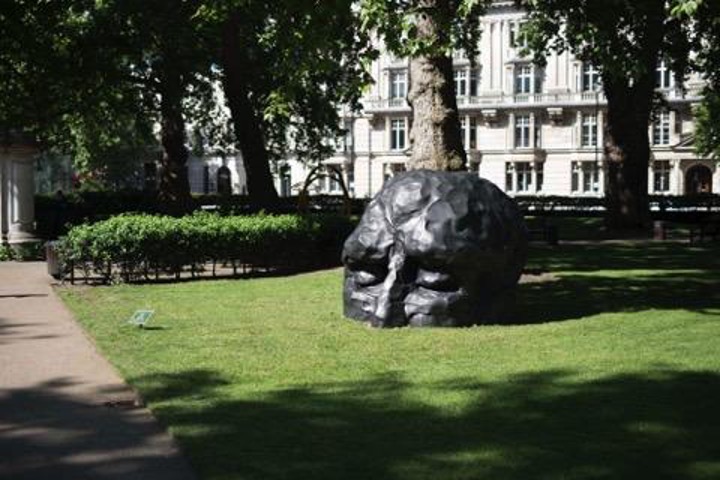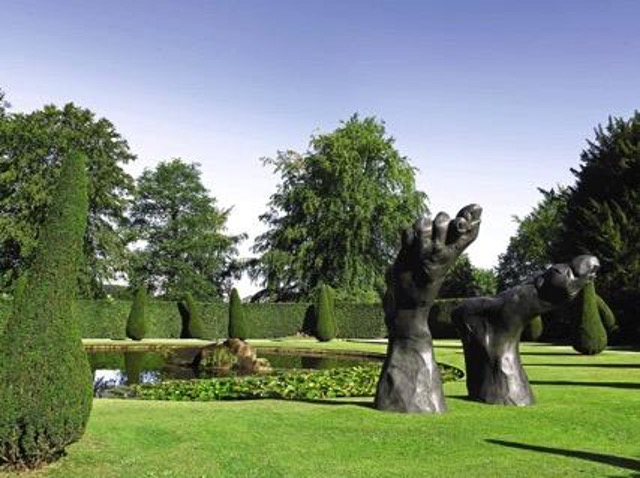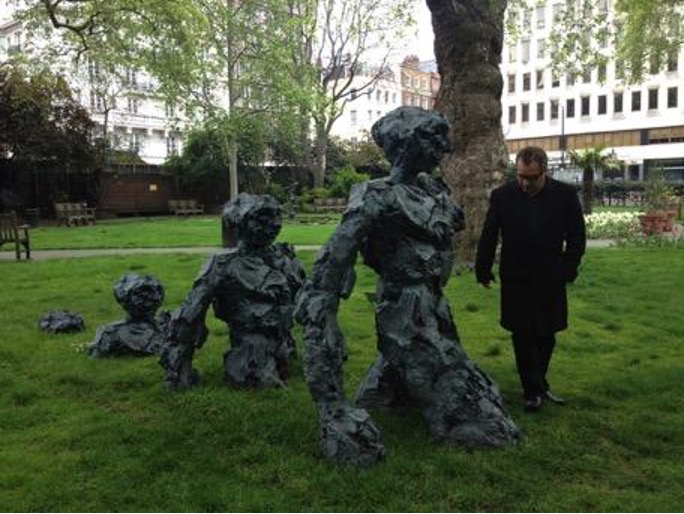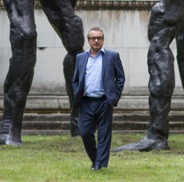This article questions the current role and relevance of monumental sculpture from the perspective of a practising artist in this field. Public art can provide a more mainstream, meaningful and free art form for the public at a time when much contemporary art is elitist and inaccessible to outsiders, as well as too focused on art as speculative investment.
In a world where much of our experience is virtual, the sheer brute physical matter of clay, plaster, stone or bronze rendered in symbolic form can affect us on a physical and psychological level, becoming a sharing of minds.

I have spent the last decade developing a new genre of monumental outdoor sculptures, psychological statements such as Brothers, a bronze arch of two figures sharing one mind. Art can be formal, innovative, decorative, or quirky, and much public sculpture can be trivial, but I wanted to dig deeper into the human condition, and for that reason many of my sculptures are partially submerged. This is sculpture that relates to the earth like the conscious mind to the unconscious. It explores ideas of life and death, the introvert and the extrovert, and archetypes, especially familial relationships. I want to use the genre of public sculpture to explore the mind through very physical means, to create sculptures that are islands of thought.

My parents were both immigrants to the UK. My father was a refugee from Nazi occupied Vienna and only got out by the skin of his teeth. Many of my works from the Alien and Visitor series are emblems of the status of the immigrant that has crash-landed from a different culture. Public sculpture has given me the opportunity to express these concerns in a passionate way that can be understood in a split second by a person walking or driving past.
Monumental sculpture is an art form that transcends both time and specific cultures, a feature of civilizations as varied as Easter Island, India, Egypt, Africa, Mexico and China: it clearly connects with the human psyche across vast geographical and epochal deserts (1). It’s part of the landscape or townscape and has been for thousands of years: sculptors today are just a link in the chain.
Outdoor sculptures are available to the public at no cost and are openly visible and debated, without the need to go to a gallery, art fair or museum. This openness stands in contrast to a widely held perception that the contemporary art world can be elitist. Public sculpture by its very nature seeks to communicate more democratically to people who did not necessarily plan to see it.
Sohrab Ahmari has provocatively noted that there can be several factors that alienate the public from the visual art culture:
“Identity politics isn’t alone to blame for an art world that inspires little more than bemused ennui in the millions who still turn to it, in vain for beauty and truth. The wider collapse of critical standards, the role of big money in the art world, the deleterious effects of social media on our attention spans, the sense that art has no new frontiers left to cross…” (2).
Part of the problem is the fact that the art world, being quite small, is a feudal system where the great majority of artists remain invisible, excluded from the mainstream because there is no system of independent critical validation. Also, because much of the art world is more preoccupied with art as an economic tool than as an expression of transcendence, much art is reduced to blank currency, meaningless to the larger public. In a recent article for the Art Newspaper, Scott Reyburn, quoting William Davies, professor of Political Economy at Goldsmiths College in London, has considered that pricing has replaced critical evaluation and meaning in the visual arts culture: “Economics has disenchanted culture, specifically visual culture. According to Davies, “converting qualities to quantities”, replacing “critical evaluation with economic, technical evaluation”, making “the price system” the ultimate judge, turning institutions into markets and individuals into competing contestants”.
Small galleries with a vibrant primary market for art works bought for their appeal or meaning rather than speculation have all but disappeared. This is partly due to globalisation: local artists are now replaced by global brands and therefore lose what was once a niche or localised market and relevance to their own culture.
Ideally there should be some formal way of providing artists with a balanced employment-art creation time split. The Federal Art Project (1935-43) was a project of the Works Progress Administration (WPA) during Franklin D. Roosevelt’s New Deal. During the Great Depression, it helped to support about 10,000 artists and craftspeople and sponsored many works of public art. Emerging from this programme were artists like Jackson Pollock, Lee Krasner, Mark Rothko, Barnett Newman, Franz Kline, Willem de Kooning, David Smith and many other major figures who came to define American 20th century visual culture. Hans Ulrich Obrist has stated: “Today, at this moment of extreme crisis in the world, a deeply worrying and precarious time for artists and for everybody, an art stimulus project similar in scale to the WPA is urgently needed”.

COVID-19 has hastened the move of the art market to the internet and may weaken the hold of the old power brokers. However, the role of the disinterested art critic in determining the significance of a particular artist or movement is still strikingly absent today. For every article in the press about the meaning, social purpose or strength of a new artwork, there are scores about auction results and the art market. As that rare breed, an independently minded New York art critic with a large following, Jerry Salz, quipped:
“I hate art auctions. Not just because they’re freak-show legal casinos, spectacles where the Über-ultrarich can act out as profligately in public as possible, trying to buy immortality, become a part of art history, make headlines, and create profit. I don’t only hate them because they may be the whitest sector in the entire world. I hate them for what they do to art, for the bad magic of making mysterious powerful things turn into numbers… The price of a work of art has nothing to do with what the work of art is, can do, or is worth on an existential, alchemical level” (3).
The over-commercialisation of new art is not helpful to artistic creation and culture. In some ways it is a fulfilment of Oscar Wilde’s famous adage about those who know the price of everything but the value of nothing. But there are complexities here as well. Although auctions can distort value, for a small number of artists it can assure income and visibility. Despite my comments, I have to say I have also benefited from it. My monumental sculptures have been sold by Sotheby’s at their Beyond Limits exhibitions, and Christie’s held a private selling exhibition of my bronzes that were installed in public spaces all over London. This has undoubtedly given me a more global audience, with prominent sculptures being placed as far and wide as the US, the Far East, Armenia, Portugal, the Middle East and elsewhere as a result.

Sotheby’s Beyond Limits, (image courtesy of Sotheby’s).
Much of the finest public sculpture or installation art of the last few years has dealt with recent historical catastrophes, such as the Berlin Memorial to the Murdered Jews of Europe by Peter Eisenman (2004) and the powerful but lesser known Ninth Fort Memorial by A. V. Ambraziunas (1984) in Kaunas. Other significant installations for memory and heritage are Rachel Whiteread’s Judenplatz Holocaust Memorial (2000) in Vienna, and Post-War works such as Nathan Rapoport’s Warsaw Ghetto Monument and the Treblinka Monument designed by Adam Haupt, Franciszek Duszenko and Franciszek Strynkiewicz.
I would like to see, in the United States, a powerful and ambitious work devoted to the horror of slavery and its legacy, because at its best outdoor sculpture can be a profound marker of past wrongs and injustices. It can also be a searing statement of the value of human life, because something happens when you see a powerful human presence made of bronze or stone emerging from the ground.
I made a work titled Emergence, a figure coming out of the earth in four stages. It is an image of the origins of humanity from the earth, evolving, growing. It is one of the few contemporary monumental sculptures to have been featured on the front page of The New York Times, which occurred during the COVID-19 pandemic. With this piece and the related versions, I wanted to make monumental sculpture a combination of philosophy, endurance and raw physical presence. I did not just want to decorate a piazza, I wanted to make a statement about who we are.

(image @ The New York Times).
My personal experience started with putting on vast subterranean exhibitions of large-scale canvases, searing indictments of our time in great raw spaces before they became gentrified, such as the Roundhouse in Camden, The Oxo Tower Bargehouse and the cavernous Vaults under Waterloo Station.
I wanted to reach out to more people, so I started making outdoor sculptures in earnest around 2011. In some ways it was easier to make an impact with monumental sculpture than with painting, which is still my main activity: I have recently completed a cycle of paintings dealing with the pandemic and lockdown.

Quite soon I had pieces in famous spots like Marble Arch, Cavendish Square, Hanover Square and opposite Euston Station. Many of these works were seen by thousands of people every hour, more than might see a painting exhibition in its whole run. Images can become part of the public consciousness even if most viewers have no idea who the artist is. You can impact the visual landscape of a city. I saw that public sculpture continues to be a topic that people care about passionately, perhaps because you are invading their space, occupying a place where a real body could stand. But also, because public sculpture raises some of the issues discussed in this article about breaking down barriers and making art less elitist and commercial.
The subject of public statuary has become fiercely debated over the last few months with the toppling of statues. In some ways the whole history of art has been one of iconoclasm. The Christian Byzantine Empire destroyed images as did Reformation Europe (4). It could be argued that every new “ism” of 20thcentury art was a form of iconoclasm, the avant-garde idea of replacing the old with the new. The attraction of monumental sculpture might be that we can leave a permanent mark. But nothing is permanent, as Shelley poeticised in Ozymandias (5).
Today it is about reshaping the future, just as 20th century sculptors such as Brancusi, Picasso, and Moore invented new forms, often inspired by ancient art or art from diverse cultures. The challenge is to make sculpture meaningful for every new generation. I studied under Henry Moore’s assistant Shelley Fausset at Central Saint Martin’s School of Art and started working in plaster and clay. The British Museum was just next door and we went almost every day to study Cypriot, Etruscan, Babylonian and Roman art. With all these influences one thing served as a backbone that still supports my artistic personality to this day: Fausset encouraged me to translate my sense of the tragedy of the human condition into sculptural form. I made a human mask out of clay that seemed to express generations of pain and endurance. The next day he handed me a piece of stone that Moore had not carved. I never carved it but got a sense that I was part of a great tradition being handed down from generation to generation, and this idea of the passing of generations became a major theme of my work in both painting and sculpture, influenced equally by my sense of my family’s history. I visited Stonehenge and the Avebury Stone Circle on a few occasions. To me these seemed to be the ultimate sculptures, simple, monolithic and mysterious.
They have continued to be a great influence, in part because they gave me a sense that monumental sculpture could be genuinely timeless, transcending the petty concerns of a fashion based cultural world and its obsession with investment.
In these sculptures I try to bring together the contemporary and the prehistoric, to show the timeless power of monumental sculpture and why it continues to have relevance in today’s world, speaking to our collective humanity through the use of archetypal images.
One of these is called Tide. Each passing generation is represented by waves of people. My thinking about monumental sculpture is that we are just one moment in time in a movement that has been pounding the beach of time for millennia.
David Breuer-Weil
References:
- Bahn, P. and Flenley, J., “Easter Island, Earth Island, the Enigmas of Rapa Nui”, 2017.
- Ahmari, S., “The New Philistines”, 2016.
- Salz, J., “Vulture”, 2012.
- Kolrud, K., “Iconoclasm from Antiquity to Modernity”, 2020.
- Shelley, P.B., “Ozymandias”, 1818.




